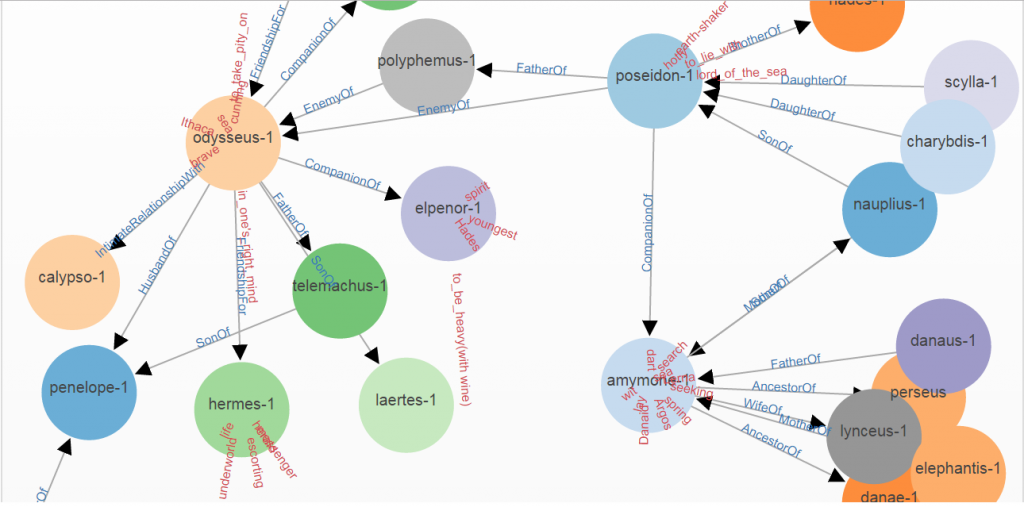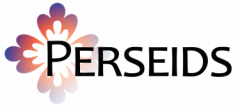How can undergraduates contribute to research in a large lecture-hall mythology class? More importantly, how can such a class get beyond the rote memorization of stories and genealogies to engage with the primary documents and understand mythology in its own context?
The Perseids team has been experimenting with annotation to tackle these questions, because annotation is well known to produce deep engagement with a text in the form of close reading while promoting collaboration and conversation among students. However, one big pedagogical challenge is to design a workflow that is simple and lightweight so as not to get in the way of learning. On the technical side, the challenge is to produce good data that can then be preserved and aggregated easily.
Our first effort had students annotating Smith’s Dictionary of Greek and Roman Biography and Mythology with the Hypothes.is web annotation tools. The assignment was to collate the relationships among the figures in an entry of the Dictionary by annotating them using Hypothes.is. For instance, in the entry for Achilles, Thetis would be tagged as “MotherOf” and Peleus “FatherOf”. These tags used the SNAP ontology as a controlled vocabulary. The annotations were then harvested via the Hypothes.is API and serialized according to the OA model. In further passes, students documented attestations of relationships, i.e. which ancient text says that this relationship existed. They did so by inserting a Perseus URI in the annotation pointing to the specific passage attesting the relationship. Students also documented places associated with mythological figures using Pleiades URIs. Finally, students associated each mythological figure with the words that ancient texts used to describe them. These characterizations were produced following the “Word Study” exercise in the “Breaking the Language Barrier” series by Anna Krohn and Gregory Crane. Students looked up the Greek and Latin words used to describe a mythological figure and associated it with an English equivalent in the annotations using Perseus citation URIs.
At the end of this multi-part assignment, students had thoroughly researched their mythological figure. They learned who the figure was associated with, not just in strict genealogical terms, but also other associations such as EnemyOf, Companion, etc. They also gained an understanding of the geographical associations of the figure, since Greek mythology is heavily based on local legends. Finally, the students got a sense for the literary treatment of the figures by looking at the original texts.
However, after using this workflow with two different groups of students, we found that while the assignment was valuable, the limitations of the tools affected the data gathered. For instance, the lack of a visualization in real time led to issues with the directionality of the relationships, so a mother could be labeled as the son of her child. Also, our instructions to the students had become very complex as we expanded the assignment with characterizations and attestations.
In order to continue and improve this work, our team began development of the Plokamos application. Plokamos is Greek for “something woven” and it allows students to build a network graph as they annotate. The application also allows users to see their annotations as a table, and the data will soon be downloadable as a CSV and as RDF.
Plokamos has an intuitive and minimalist interface which cuts down on the time needed for annotation and the possibilities for user error. As a result, our instructions to the students became much shorter and simpler. Plokamos also has an attractive interactive visualization which helps to see the characterizations in the context of the network and make sense of the two together.
For instance, students working on Odysseus and Amymone noticed that both these figures, who appear on each side of a Classical pelike in the Boston Museum of Fine Arts, are connected to Poseidon and his offspring of aquatic monsters (fig. 1). These monsters are further connected to Odysseus because they are all eventually pitted against him and defeated. The characterizations strengthen these connections, as Odysseus is depicted with seafaring epithets, bravery, and sound thinking, while Poseidon is depicted with sea epithets and words indicating fertility and progeny. Finally, Amymone is associated with bodies of water such as springs and lakes, and with her descendants, the Danaids, who carry water eternally in Hades. In this way, Plokamos helped students to gain a better understanding of mythology at the conceptual level, and then apply this knowledge to a specific piece of ancient artwork.
 Fig. 1 Social network of Odysseus and Amymone, by Christopher Duff and Patrick Margey
Fig. 1 Social network of Odysseus and Amymone, by Christopher Duff and Patrick Margey
